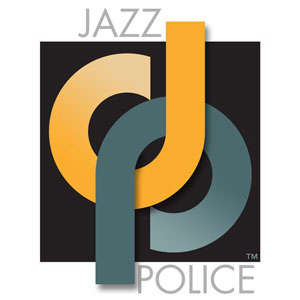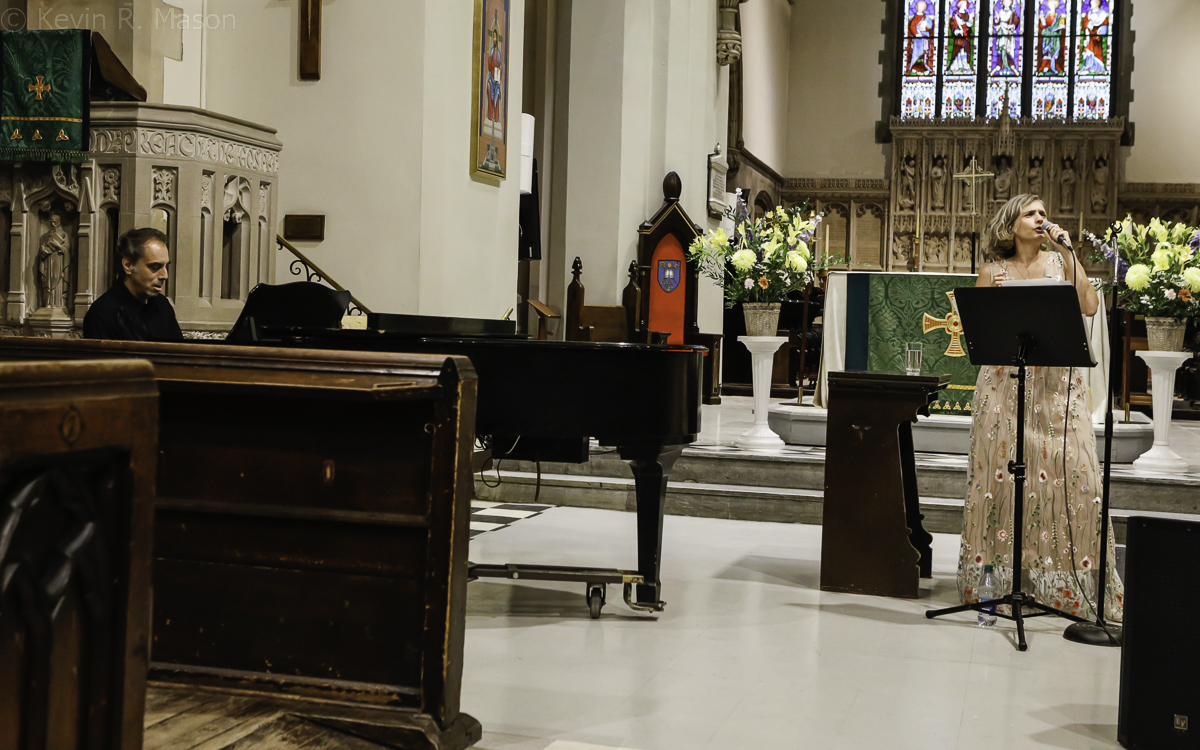
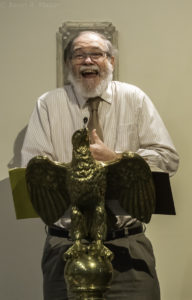
The Montreal Jazz Festival, officially titled Festival International de Jazz de Montréal, fills the city with so much music, that it spills over beyond the Festival itself. One of the most notable events was a series of concerts/art exhibitions hosted and curated by eminent Canadian Religious Studies scholar and host of numerous interviews with jazz musicians (that he calls “Dialogic” sessions), Professor Norman Cornett.
The exhibition and concert series, Jazz/Art in the Cathedral, was held at Cathédral Christ Church Montréal. From June 29 to July 10, there was an exhibition that featured the artwork of the following artists: Janet Read, Juan Aquino, Sandra Morellato, Richard Duret, Maurice Murphy, Sekai, Helene Routhier, Noelle Lemos, Helene DeSerres, Suzanne Ledoux, and John Pohl. There were also several events that featured music.
Holy Ground: Encountering God in the City
The series started with a lovely Jazz Vespers, Holy Ground: Encountering God in the City, on Sunday, July 3, in collaboration with Professor Cornett. The Reverend Dr. Deborah Meister served as celebrant, pianist Matt Herskowitz performed, and vocalist Ranee Lee (who won the Oscar Peterson Award at this year’s Festival) was the homilist.
There were several readings of quotations and scriptures by Marie-Claire Fournier, Esther Guillen, Robert King, Diana Bouchard, and Michel Gagnon, in both French and English, that included “Thanks” by W.S. Merwin and a reading from “St. Augustine, City of God.” Matt Herskowitz (Juno, Felix, and Grammy nominee, who was one of Dave Brubeck’s favorite pianists) played beautifully throughout the service, and his repertoire included “Song of Moses” by Aaron Keyes, and “All Good Things,” which was composed by Herskowitz. In this service, Matt showed just how powerful a piano alone can be, and he followed a prayer with another of his compositions, a moving blend of jazz, blues, and gospel that was a thing of beauty to hear.
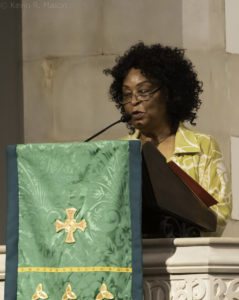
Juno Award winner, member of the Order of Canada, author, and educator Ranee Lee gave an illuminating homily, and here are some excerpts from it:
“Music is a Universal Language. It has the unique ability to communicate and connect us to the universe in ways that cannot be found elsewhere. The Universe is the creation of the Holy Architect, and we are the energy that emanates from the Creator.
In theory, jazz is a powerful spiritual communicator…Throughout history, music has been used in cultural and spiritual ceremonies in ways to survive, find strength, and build endurance. Whether in the form of a cappella singing, chanting, or percussions, it was proven to be spiritual…Jazz music is the offspring, and…if we are open to the saving and healing powers of jazz, it often resonates on a much deeper and individual level…The music of jazz embraces influences from every and any genre of music and is open to influencing any and all other styles in return. This distinction has allowed me, from personal experience, to gratefully explore the landscapes of my own performances as a jazz vocalist.
Whatever your desired choice of music, it does affect the mind, body, and spirit in substantial ways. Think of the times…when…music has been the soundtrack of a particular or important event in your life…Its uniqueness can fill you with an indescribable sense of presence and community, this is a spiritual, and musical moment!…Because music is an emotional conduit that carries our feelings and sentiments in lyrics or instrumental phrases and is rhythmically balanced like the beating of the heart…The art form of jazz…instrumentally or lyrically…imports significant talents that represent the human connection…When we consider the music of jazz, it is a form of worship.
Each note can reflect eternal passion, and reverence that identifies the soulfulness in the interpretation and performance of the players, composers, and the arrangers spiritually…When we connect to…the audience who shares the same jazz experience, we ultimately commune in spirituality.
In ancient times…humans relied on notes and melodies for spiritual and religious worship, because they recognized the true power of music, much as we experience it today in our hymns, songs of worship and gospel music. But as far back as 3000 BC, society would strictly keep music only for religious ceremonies and the elite. Eventually music would be adopted by the common people…finally uniting us as jazz enthusiasts…When we speak of the music of jazz and the universality in which it’s perceived, its musical rituals, and individual contribution become collective goals…I personally experience the positive, and liberating venerable commandments of jazz, and it is therapeutic!
In a most significant demonstration of spiritual connections, the outstanding devout contributions to the art form of jazz are reinforced by numerous notable instrumentalists and vocalists alike, drawing from their inward beliefs and convictions, reinforced by the strengths of their musical knowledge and performances, all seem to work in synchronicity…A quote…from Dizzy Gillespie:…“When I encountered the Baha’i Faith, it all went along with what I had always believed. I believed in the oneness of mankind. I believed we all come from the same source, that no race of people is inherently superior to any other.” Becoming a Baha’i influenced Gillespie’s life in every way. He wrote that it gave him “a new concept of the relationship between God and man—between man and his fellow man—man and his family.” “I became more spiritually aware, and when you’re spiritually aware, that will be reflected in what you do.”
John Coltrane was perhaps the most outspoken spiritual jazz musician…In the liner notes of his recording of A Love Supreme (1965), Coltrane states that in ’57 he experienced: “By the grace of God, a spiritual awakening which was to lead me to a richer, fuller, more productive life. At that time, in gratitude, I humbly asked to be given the means and privilege to make others happy through music.” He presented it as a spiritual declaration that his musical devotion was now intertwined with his faith in God. In many ways, the album mirrors Coltrane’s spiritual quest that grew out of his personal troubles, including a long struggle with drug and alcohol addiction.
Harpist and pianist Alice Coltrane’s legacy has been somewhat shrouded by the legacy of her husband, John Coltrane. In fact, few know that she replaced McCoy Tyner as pianist in John Coltrane’s quartet until Coltrane’s death in 1967. [She was] an incredibly gifted avant-garde musician, composer, and arranger, who was also deeply moved by two spiritual experiences that subsequently became integral to her body of work. Left alone to raise her four children, Alice Coltrane sought truth through meditation and prayer, and traveled to India. There she said, she was called into God’s service. As a result, her work incorporates many of the aspects of India’s Hindustani musical traditions like drones, ragas, Tabla drum, and sitar. Her innovative work, especially her collaborations with saxophonist Pharoah Sanders, are…sublime.
The name Duke Ellington is synonymous as a contributor to the foundation of big band jazz, and a legendary composer of many great works of historic arrangements, but equally he was highly influenced by his Christian roots. In a spiritual biography, he is quoted to say, that his great passion…springs from the awareness of the presence of God in all of life! Ellington’s “Black, Brown and Beige Fantasy” which also featured the angelic and soulful sounds of Mahalia Jackson, is a wonderful example of the music of Faith, Soul, and Jazz.
We don’t have to revisit the past of great spiritual music influences, in our own community and presence today, we have a genuine spiritual music advisor. He is known as a great musician, a brilliantly skilled pianist with passion, love and empathy that shines as the spirit moves through him pouring out grace and soulfulness with friendship and humanity… Players and listeners alike are filled with the serenity and benediction of his message through his spirituality and the music of Oliver Jones.
Jazz musicians often see themselves as musical story tellers, which I have a strong and personal connection to as well…I have recently read that the word “music” is divided into two parts. Mus: which translates in Hebrew to “Something that’s been taken out-of-something” i.e., improvisation, and ic: which means “Spirit” in Ancient Egyptian, making music by definition, Spiritual!…Jazz is sometimes cool, sometimes hot, sometimes simple and uncomplicated. Sometimes complicated, sometimes serious, sometimes playful, sometimes easy, and sometimes intense, sometimes adventurous, sometimes fast, sometimes slow, sometimes happy, and sometimes lamenting, sometimes smooth, sometimes explorative, sometimes elegant, sometimes no holds barred, sometimes swinging, sometimes straight, sometimes chaotic, and sometimes highly structured and orderly, sometimes grooves hard, and sometimes suspends all sense of time! Sometimes improvisational, sometimes traditional. But always personal!…In any case, the interpretive nature of jazz is a universe in itself… and jazz is spiritual!…Amen!
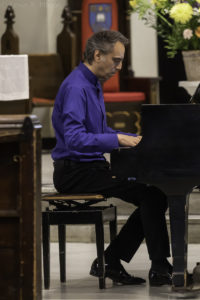
After the homily, Matt Herskowitz played a sparkling rendition of Carole King’s “You’ve Got a Friend.” He followed with Juan Filipe Herrera’s “Almost Livin’ Almost Dyin’,” which was a powerful protest against police brutality. Herskowitz played a vibrant version of Prince’s song “The Cross,” and after a reading from The Revelation to Saint John, Matt played a vivid version of Steve Windwood’s “Back in the High Life Again.” The final reading was from American monk Thomas Merton, after which Herskowitz performed “There’s a Leak in This Old Building” by A.C Littlefield. This was an old-time, rousing church song that was played with fire by Matt. This service was inspiring for all the attendees, and the perfect spiritual break for busy Festival goers.
Matt Herskowitz and Mademoiselle Balladin
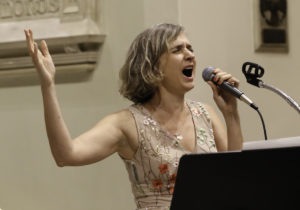
On July 5, the duo of Matt Herskowitz and French vocalist Mademoiselle Balladin performed beautiful musical selections in an emotional and introspective concert, with some percussive numbers. The songs included “Silence,” the light and up-tempo “Irrésolue,” “Chanter,” “Aquatique,” “Caméléon,” the bluesy “L’heure du Goûter,” and beautiful ballad “Bergamote.” Matt performed with passion and enthusiasm, and Mademoiselle Balladin charmed the audience with her unique song stylings.
Notably, Herskowitz and Mademoiselle Balladin had only met two days earlier, since this was her first time performing in North America. Despite the shortness of their acquaintance, there was a wonderful unity of improvisation and purpose in their duets at Christ Church Cathédral. All the donations that day went to Balladin’s charity organization for children, Arts & Enfance. This organization is dedicated to having art help sick children to recover, and children in precarious positions move towards resilience.
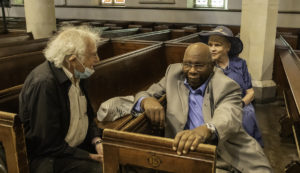
July 6 was the final day of Jazz/Art in the Cathedral. Professor Norman Cornett discussed the artwork that was on display, then introduced Canadian living legend, pianist Oliver Jones. Professor Cornett also discussed the documentary film Oliver Jones in Africa. Celebrated filmmaker Martin Duckworth, who directed the documentary, was also in attendance. Duckworth has received Government of Quebec’s Prix Albert-Tessier, which is given to individuals for an outstanding career in Quebec cinema, and he spoke briefly about the documentary.
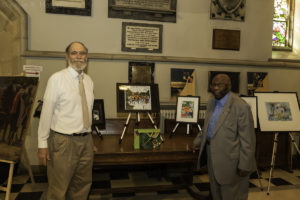
Then, Oliver Jones was escorted to the part of the Cathedral where the artwork was displayed. Once he got to the place where the exhibit was held, Jones commented on each of the artists’ work, offering a musician’s perspective in his approach to his musical gifts and made comparisons to the artists’ creations. Sandra Morellato, Janet Read, Suzanne Ledoux, Sekai, John Pohl, and Juan Aquino were the artists who were there in person, presenting their very individual and different takes on art.
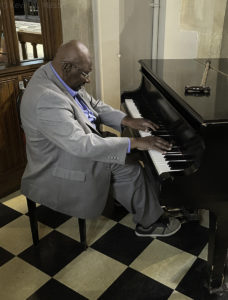
Professor Cornett reminisced about a special Dialogic session with Jones and Duckworth, while he was teaching a class. He said, “I told all my students that for Oliver Jones to come into my classroom is like being a little boy again.” Cornett then spoke of watching The Wonderful World of Disney on his family’s Black and white TV in the 1950s, reciting the Disney closing theme to his students as Jones began playing the theme on the classroom piano. Oliver Jones was surprised that Cornett would remember that occasion. On the way out of the art exhibition area, Jones passed a piano, and he could not resist performing an impromptu, sumptuous and lovely “When You Wish Upon a Star” in honor of having performed it at that Dialogic session 20 years ago. It was a touching and sentimental moment, and although Oliver is largely retired from performing, he has not lost a step on the piano!
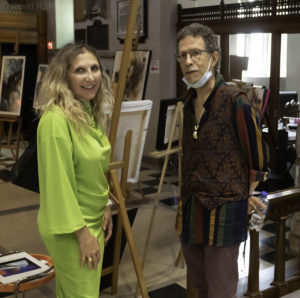
After the exhibition, a question-and-answer period followed where the artists replied to queries about their work. Then, prize-winning pianist Matt Herskowitz (who Cornett described as a chameleon who is very adaptable) and Mademoiselle Balladin (whose given name is Camille Rousset, is also a lawyer and writer, as well as being a jazz singer) once again took the stage. The songs they performed ranged from emotive and melancholic to sultry and bluesy, and this concert was a wonderful closing for Professor Cornett’s presentations. This series of events was a feast for both the eyes and the ears, and a great addition to the music that takes place in the city during Festival International de Jazz de Montréal!
